
Looking for Intercom alternatives? You are not alone.
Intercom is a robust customer service platform beloved by many teams, but its expensive pricing plans, poor customer support, and overwhelming user interface may be deal-breakers for some.
As product experience experts, we tried and tested 10 alternatives for different use cases, from user onboarding to customer support, and lead generation. In this article, we’ll share our insights and hopefully help you make a decision.
Try Userpilot Now
See Why 1,000+ Teams Choose Userpilot

Overview of Intercom features
Intercom is a robust customer support platform that combines customizable live chat widgets, an omnichannel help desk, and proactive support features in one place. Overall, Intercom helps companies to strengthen customer relationships and improve user experience through personalized support.
Here’s a quick recap of Intercom features:
- AI-powered shared inbox for omnichannel support. The AI can help agents expand answers, save them for future replies, or create tickets.
- FinAI chatbot to handle live chat conversations. It scraps information from your knowledge base or resource center and gives relevant answers to users.
- No-code workflow automation for customer service teams to set rules, conditions, and triggers to processes and automate repetitive tasks, e.g., rerouting tickets.
- Product tours to guide users through your platform proactively and reduce the chances of having them contact the support team.
- Email marketing tools to engage with customers outside of the app or website.
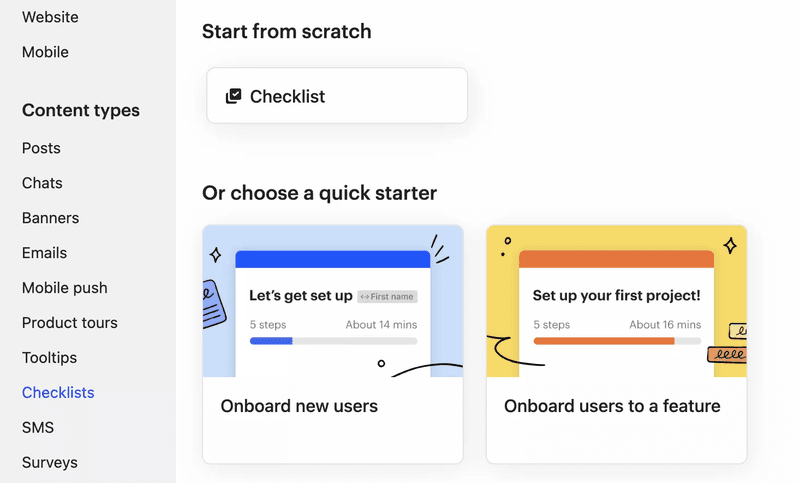
What’s the biggest challenge you’re facing with your current customer support or onboarding tool?
What is your primary goal right now?
How many monthly active users (MAUs) do you have?
It looks like Userpilot could be a great fit for you.
You don’t have to settle for generic tools. See how a dedicated product growth platform can help you achieve your goals. Userpilot is one of the top Intercom alternatives for teams that want to improve user onboarding and drive adoption.
Reasons to look for Intercom alternatives
According to our research, here are some of the biggest drawbacks of Intercom:
- Expensive pricing. Intercom’s pricing structure is complex. It charges a fee per seat but also has an added cost for each AI chat resolution, an extra $99 per seat for product tours, and a fee per outbound message after you reach your plan’s limit. As you scale, costs add up, and it can quickly become too expensive, especially for mid-size companies.
- Lack of specialized features for some use cases. Intercom tries really hard to do it all and offers features for handling all aspects of the customer experience. However, while the product is broad, some features are lacking in depth, namely the ones for email marketing and user onboarding use cases.
- Cluttered UI/UX. Not only does the platform have a steep learning curve, but it’s also quite non-intuitive, and even power users sometimes find it hard to navigate “I often find myself Googling where specific features live, even after years of using it. Improved in-platform navigation and searchability would make a big difference,” says M J C, Intercom user.
- Poor customer support. Even though Intercom is a customer support tool, users often complain about its own service quality. “Being a live chat solution, they need over 24 hours to get back to you if you reach out to their customer support. I believe that shouldn’t be an issue for a company like Intercom,” says Valentina K., Intercom user.
Best Intercom product tour alternatives
While product tours aren’t Intercom’s main use case, the platform offers guided tours as an add-on.
Intercom lacks dynamic features and UI patterns for building personalized onboarding flows. It also doesn’t offer localization for product tours, and you can’t access in-depth analytics.
Let’s explore these three Intercom product tour alternatives:
1. Userpilot
Userpilot is an all-in-one product growth tool that offers features for building personalized onboarding flows, analyzing in-app user behavior, and collecting user feedback.
Key features:
As a product tour software, Userpilot offers:
- No-code editor. Design code-free product tours right from an intuitive Chrome extension that sits on top of your product.
- Multiple UI patterns. Choose from banners, modals, tooltips, or slideouts to craft standalone in-app messages or combine them into multi-step tours for engaging users. Moreover, you can customize the design to fully match your branding without CSS and even embed rich media elements.
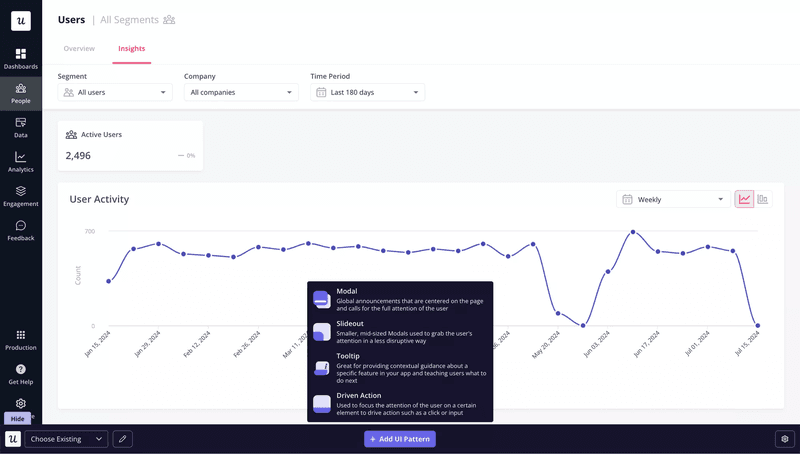
- Localization. To create more accessible and personalized product tours, Userpilot allows you to translate in-app content based on user properties like locale or browser language. You can choose between automated AI translations for quick setup or manual file imports for full control.
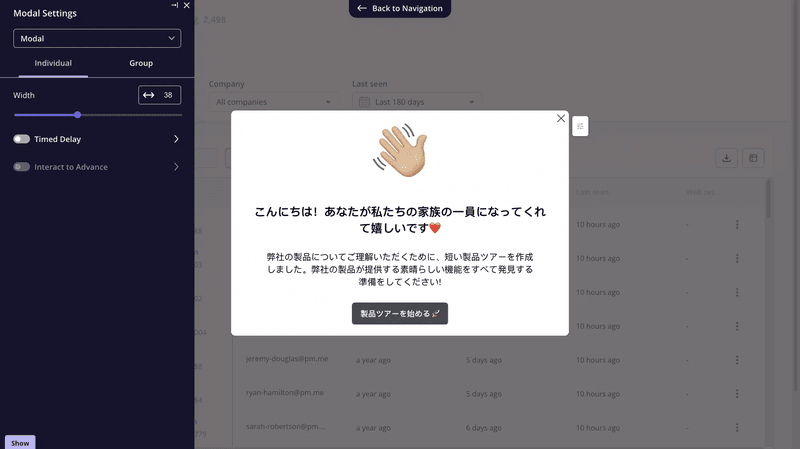
- Contextual triggering. Using a combination of event-based triggering and user segmentation, you can ensure that the right product tour is shown to the right user at the right time.
- Flow experimentation. Conduct head-to-head or controlled A/B tests or controlled multivariate tests to identify which product tour leads to more engagement or conversions.
- Flow performance tracking. Get insights into metrics such as the number of times a flow is shown, completion rates, dismissals, and average time to completion. Additionally, it offers step-by-step breakdowns to identify friction points and optimize them.
- Resource center. Create an in-app hub and embed different help resources such as interactive tours, checklists, articles, and live chat users can access whenever they come across issues.
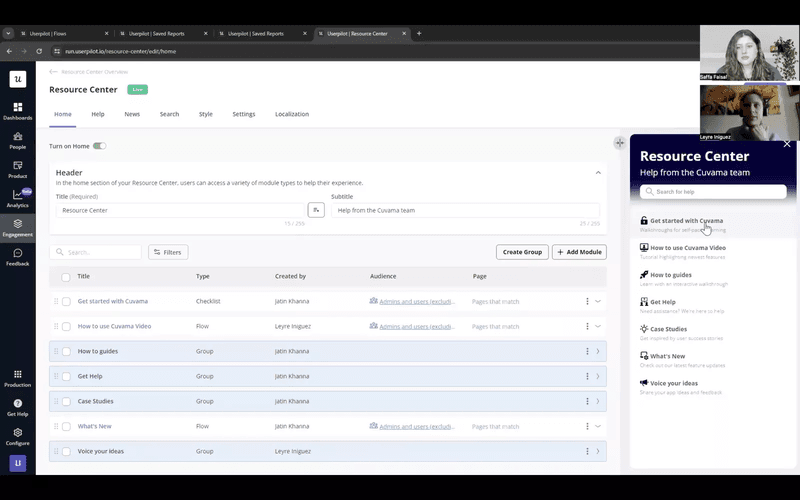
Userpilot vs Intercom: The Final Verdict
There is no question that Userpilot is a better choice when it comes to product tours.
First, Userpilot has a wider range of UI patterns for creating flows and allows for more personalization (e.g. custom themes, flow triggering options, and localization).
Next, Userpilot offers several features for analyzing the performance of product tours in detail, while Intercom offers only basic analytics.
Finally, Userpilot enables businesses to create dedicated resource centers, where product tours can be embedded into and launched on-demand, while Intercom doesn’t offer anything close to this.
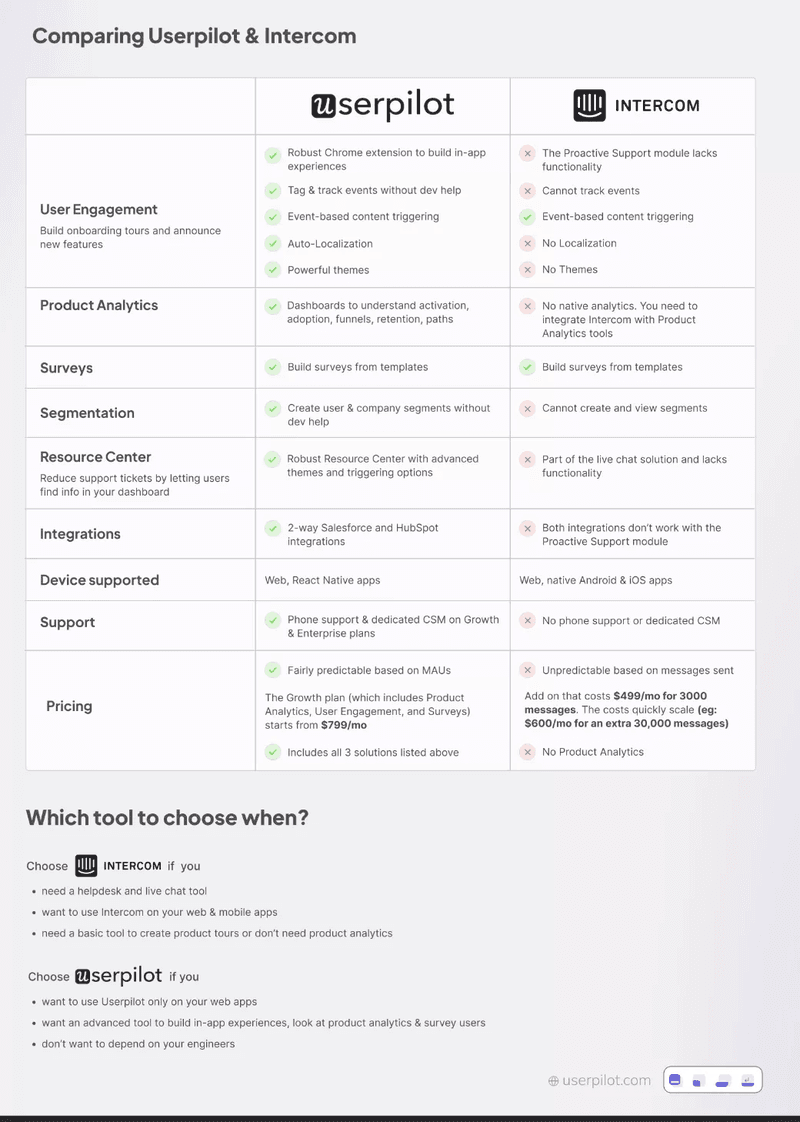
Don’t take our word for it, here is what one of our customers who switched from Intercom has to say:
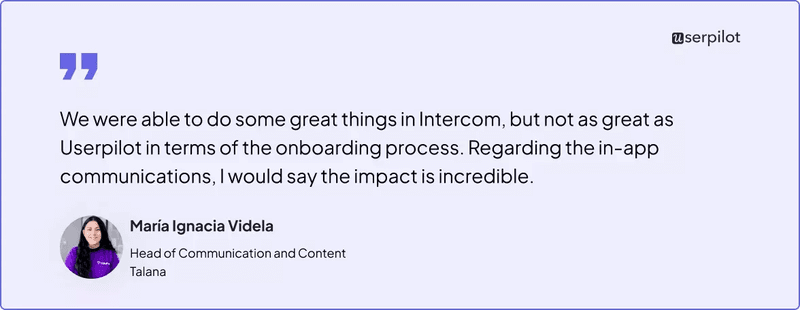
Pricing
Unlike Intercom, Userpilot follows a transparent pricing strategy that makes billing predictable. Userpilot charges by monthly active users (MAU), not seats or chat responses.
Prices for Userpilot start at $299/month(billed annually) for up to 2,000 MAU.
2. Appcues
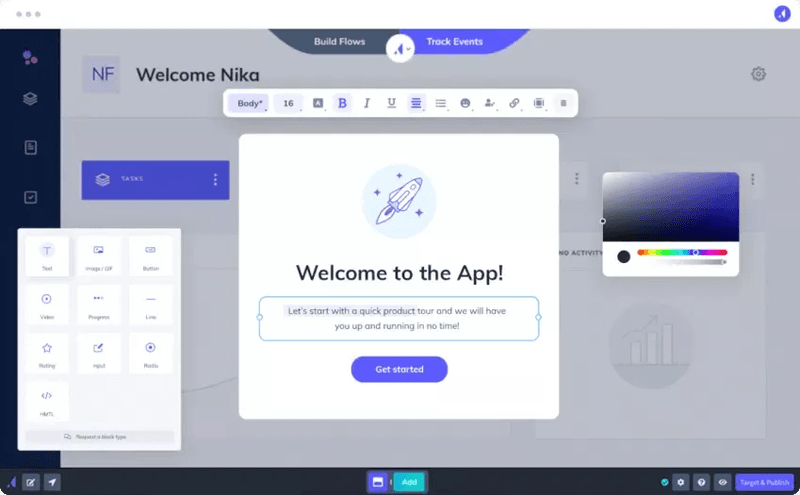
Appcues is a user onboarding and digital adoption platform (DAP) that works for mobile and web apps.
Key features:
- Drag-and-drop no-code builder to craft onboarding flows and in-app messages.
- Multiple UI patterns, such as tooltips, hotspots, and pop-ups.
- Audience segmentation by role, user persona, or lifecycle stage.
- Detailed analytics with insights into user activation.
- A/B testing onboarding flows.
If we compare Appcues vs Intercom as product tour tools, we can say that Appcues has better analytics capabilities. It also allows you to A/B test your onboarding flows and customize the design of your workflows without needing to write any code.
However, Intercom offers live chat software and omnichannel support, something you can’t do with Appcues. Also, Appcues charges by MAU, not seats or add-ons.
Pricing
Prices for Appcues start at $249/month* for up to three seats and 2,500 MAU. To access localization and white-labeled proactive support features such as building a resource center, you need to pay for its mid-tier plan.
3. Pendo
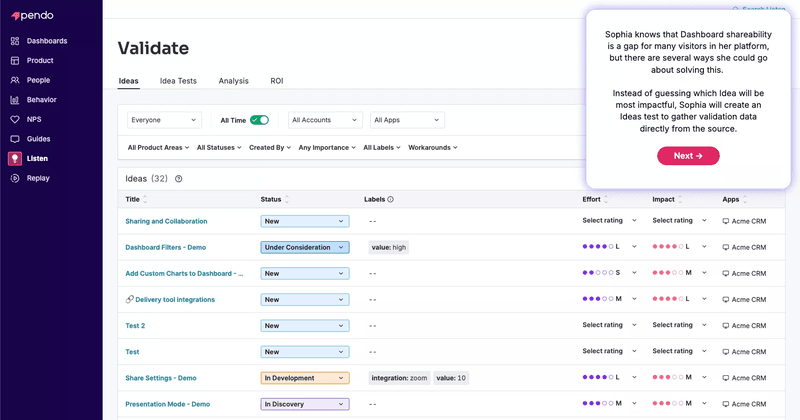
Pendo is an all-in-one platform for offering a seamless customer experience. It’s specially tailored for marketing and product teams with a strong need for behavioral analytics.
Key features:
- In-app messaging to show users how to navigate your user-friendly interface.
- UI patterns to choose from such as tooltips, polls, modals, lightboxes, onboarding checklists, and banners.
- Polls to launch in-app NPS, generic, or customer satisfaction surveys.
- Localization is available. However, you need to manually upload the CSV file with translations for localization to work.
- Contextual support with mobile responsiveness.
Pricing
Pendo pricing isn’t publicly available but users say they find it expensive. Plus, Vendr, a SaaS negotiating company, shares that annual contract prices for Pendo usually range from $12,500 to $132,400.
Best Intercom alternatives for customer support
As a customer service software, Intercom is one of the top-rated solutions in the market. However, it can get expensive quickly as it charges a fee per each AI-powered chat resolution and additional answers via customer support channels.
Let’s explore customer service platforms as potential Intercom alternatives:
4. Zendesk
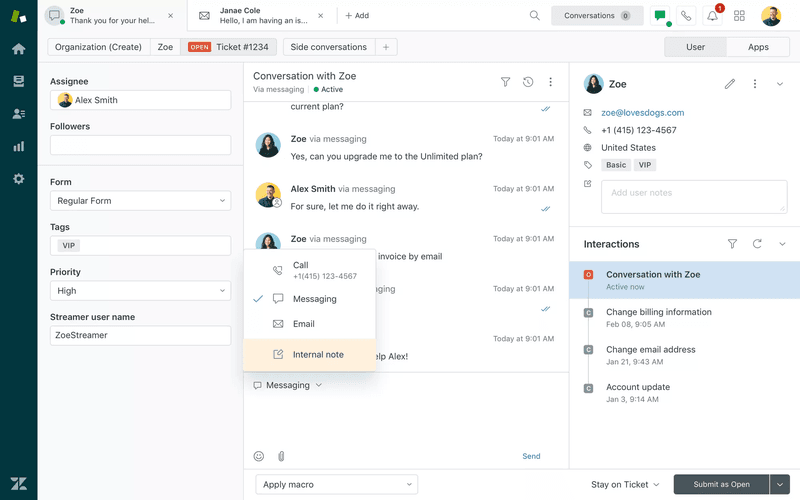
Zendesk is a customer service software tool mostly suited for enterprises. It’s also AI-powered and offers high-quality customer service to employees and customers.
Key features:
- Help desk creation with a chat widget to empower customer self-service support.
- Ticketing system that lets you assign tasks to different people on the service team.
- Shared inbox to offer omnichannel support through various customer communication channels such as email, chat, voice, and social messaging.
- Out-of-the-box automation features such as predefined responses or custom rules.
- In-depth and robust data analytics in a dashboard.
Zendesk’s shared inbox is more suited for omnichannel support, Intercom’s inbox is more focused on automation (e.g., rerouting tickets), and you may need to pay extra to bring in all of your channels. Zendesk also has higher reporting and analytics.
Intercom, on the other hand, has a more conversational chatbot that looks into solving problems first before creating a ticket. The two can also be used as customer relationship management (CRM) tools, but Zendesk’s Sell plan comes at a different price. Zendesk also integrates with almost twice as many tools and advertises itself as more scalable than Intercom.
Pricing
Prices for Zendesk’s customer service platform hub start at $19/agent/month*, plus the cost of add-ons that range from $25 to $50 each.
*Billed annually.
5. LiveAgent
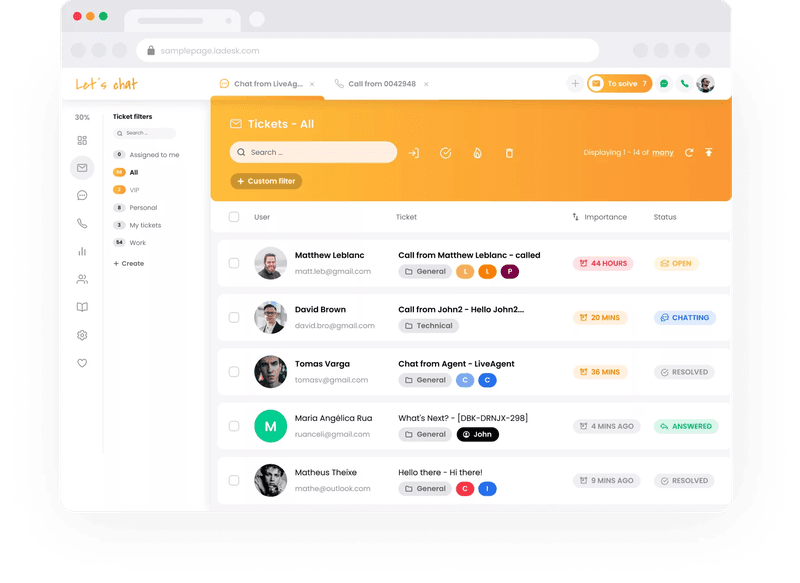
LiveAgent is a help desk software that captures all user messages and sends them into its ticketing system for easy management and resolution. This way, you can answer users fast, organize support team communication and tasks, and improve team performance (based on data).
Key features:
- Live chat support with features such as real-time typing view, predetermined answers, and proactive chat invites.
- Call center to support users on the phone and see the collected customer data on screen during the call for a personalized service.
- Omnichannel support allows you to create tickets or answer messages from any channel through a shared inbox.
- Knowledge base creation to enable proactive self-service support.
- Workflow and task automation with custom rules.
The biggest difference between LiveAgent and Intercom is the use of AI. LiveAgent is much more human-reliant. It uses automation by allowing customer support agents to use canned responses or to automate workflows, but chats are mostly answered by real agents. LiveAgent also creates tickets based on knowledge from past customer interactions instead of making agents answer each question manually.
Meanwhile, Intercom relies heavily on AI to answer messages, create and assign tickets, and go through workflows.
Pricing
LiveAgent starts at $15/agent/month*. It comes with a free trial and charges an additional $39/month for social media integrations, such as Twitter or Viber. There’s a bundle of Instagram and Facebook messenger integrations available for an extra $19.
*Billed annually.
6. Help Scout
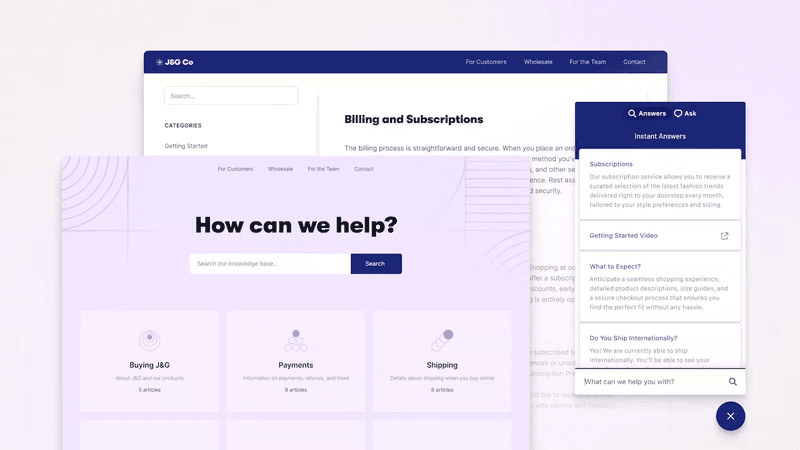
This is a customer support platform for teams who want to offer immediate support to their users. Help Scout comes with automation features, a shared inbox, and AI-powered functionality.
Key features:
- Team collaboration tools for assigning tasks, adding private notes, showing who’s seeing or replying to a message, and building AI-powered summaries.
- AI Assist for fixing the grammar in messages or making them shorter, longer, or friendlier.
- Beacon messaging to offer in-app support via a live chat, emails, proactive messaging, or redirecting users to your help desk.
- Powerful analytics to make data-driven decisions based on previous conversations and customer satisfaction scores.
In comparison, Intercom is fully AI-powered but Help Scout uses AI where matters, e.g., to perfect human-written messages or automate tasks. Help Scout also has a higher user rating in ease of use and customer support, and it’s more scalable due to its transparent pricing strategy.
Pricing
Prices for Help Scout start at $22/user/month for up to 25 users. It doesn’t have any hidden fees or plans that get more expensive with time.
7. Tidio
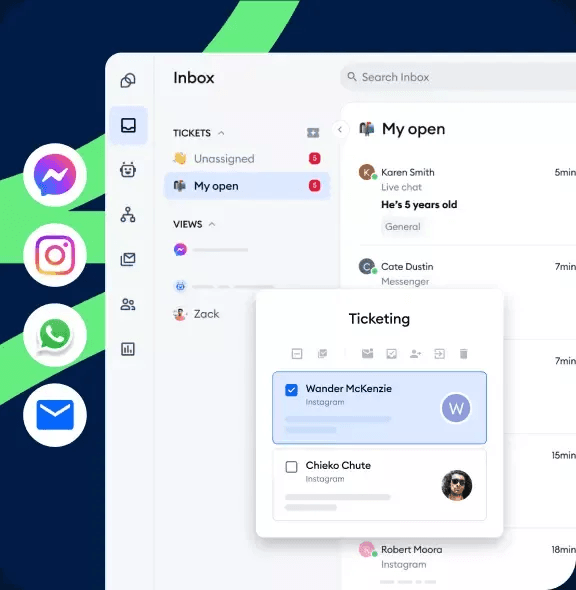
Tidio is an AI-powered customer service software for businesses of all sizes. It claims that you can solve 70% of all user interactions without manual intervention.
Key features:
- Lyro AI conversational chatbot to answer customer inquiries on any live channel and in multiple languages.
- Predefined or custom flow automation for sales and support teams to move leads through your funnel—e.g., offer discounts or recommendations.
- Ticketing system with priority management and advanced features to turn user conversations into tasks, add filters, and route tickets.
- AI-powered messaging features for agents.
As an alternative to Intercom, Tidio is more affordable and offers better customer support to its users. Both of these tools rely heavily on AI to answer customer queries and reduce manual tasks.
Also, Tidio charges $0.5 per AI chat, despite the number of internal resolutions. Intercom, on the other hand, charges $0.99 per each AI-generated resolution, which can be multiple in a single chat.
Pricing
Tidio offers a free plan that supports up to 50 conversations per month. Then, prices begin at $29/month for 100 conversations and basic analytics. You can also pay for add-ons to enjoy AI-generated responses and automated flows.
8. Gorgias
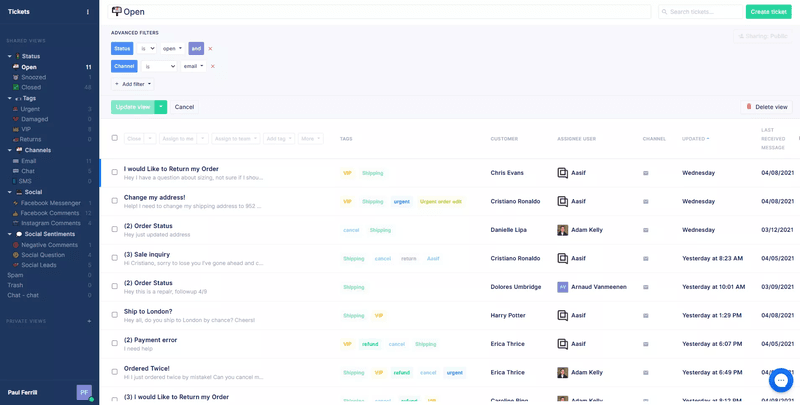
This customer experience platform for e-commerce uses customer interactions to make personalized offers, give recommendations, and share solutions via customer support.
Key features:
- Shared inbox that lets you send updates directly to Shopify through a seamless integration.
- AI chat to answer common customer inquiries regarding shipping, order status, returns, or exchange questions.
- AI-powered agents that handle ticket resolution, not just answer users, to increase response rate and customer satisfaction.
- Help desk with a detailed customer profile internal view to offer proactive and personalized support every time they reach out.
Compared to Intercom, Gorgias was built for e-commerce businesses, not SaaS tools. This makes Gorgias focused on increasing revenue and that’s why it excels at sharing personalized on-page discounts, recommendations, and offers.
Intercom is constantly developing its AI technology to offer improved customer satisfaction but Gorgias strengthens its AI to drive sales. So, on top of having AI answer recurring questions, Gorgias’ AI analyzes on-page user behavior and triggers contextual purchase suggestions that increase revenue.
Pricing
Prices for Gorgias start at $300/month for approximately 2,000 help desk tickets, plus $0.36 per additional ticket. You can also pay for voice or SMS add-ons.
Best Intercom competitors for lead generation
While Intercom is primarily an excellent customer service software, it lets you store contacts, build segments, and add tags to leads. It also lets you send outbound omnichannel messages to your prospects. However, since it’s not a dedicated lead-gen or CRM, here are two Intercom alternatives for said purposes:
9. HubSpot
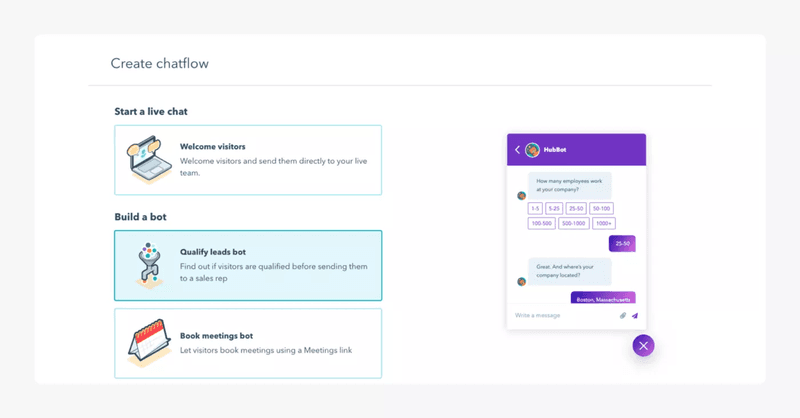
HubSpot is a cloud-based tool that combines a set of products for managing business operations. Both the HubSpot service hub and its free CRM compare to Intercom.
Key features:
- No-code website form builder and editor to capture the contact information of your website visitors by using a design that matches your brand.
- Multichannel customer communication, reach them through email, SMS, or social media.
- Pipeline view to visualize prospects and their likelihood to convert on the CRM.
- Dashboard and reporting with access to metrics on the state of your leads, prospects’ warmth, and campaigns.
In comparison to Intercom, HubSpot service hub allows you to review all customer interactions in your CRM, including off-page behaviors. In addition, HubSpot uses a universal inbox across the company so every customer-facing employee has the same information. Intercom’s customer portal, on the other hand, separates inboxes by team.
Both tools allow you to take customer requests, offer reactive and proactive support, and chat with users through different channels. However, HubSpot allows you to keep nurturing the relationship with customers, collect payments, create marketing content, and improve customer engagement through its additional products.
Pricing
The HubSpot CRM is free to use as well as the online form builder. Access to the complete HubSpot Service Hub starts at $90/seat/month*. Prices for the Marketing Hub start at $800/month* for three seats.
*Billed annually.
10. Salesloft (formerly Drift)
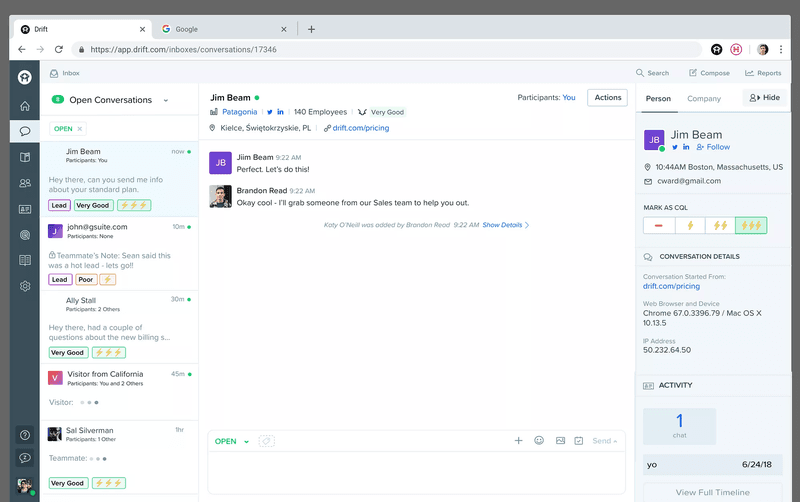
Salesloft is an AI-powered revenue orchestration tool. This means that it allows you to reach out and interact with prospects and clients at the right time. Salesloft acquired Drift earlier this year and now offers tools for capturing leads, improving the user experience, and increasing customer engagement.
Key features:
- Custom or out-of-the-box AI-powered chatbot to answer prospects’ questions without manual intervention.
- Live chat with customers to nurture the leads right away without waiting for them to fill out a contact form.
- Advanced reporting, including chat ROI and conversational intelligence, to measure the effectiveness of demo calls.
- Auto-generation of next steps emails based on sales calls.
As an alternative to Intercom, Salesloft is much more sales-driven and focused on generating revenue—and showing managers where the money is coming from. While Intercom does a great job at delegating internal work and keeping track of contacts and leads, it lacks such advanced reporting capabilities.
Intercom is also much more driven by customer support, while Salesloft is focused on prioritizing the actions that drive sales.
Pricing
Salesloft prices are only available per request. However, according to Vendr, Drift contracts tend to vary from $45,834.93 to $281,040 a year. We have no knowledge of price changes after the acquisition.
Conclusion
If you’re looking for Intercom alternatives with the same features for customer support, you may benefit from using Zendesk. If you want a tool that relies less on AI, try LiveAgent. If you have an online shop, stick with Gorgias.
However, if you want a tool to replace Intercom as your CRM, try HubSpot if you’re a small business. Switch to Salesloft when you have the budget.
Lastly, try Userpilot for building highly personalized user onboarding flows, gathering feedback, improving your product experience, and viewing detailed analytics—all in one place. Get a demo.








